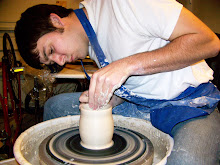The way I understand it, crazing is cracks in the glaze due to poor fit that can make the pot somewhat weaker and can also harbor bacteria in these small cracks. I have also been told that if your wares are not fully vitrified, they can allow moisture to absorb into the clay body and either get hot when microwaved or even break. They can even make otherwise safe glazes leech.
With that said, I use many pots daily (both pots made by me as well as other potters--some of them very well known) that have crazing and go through the dishwasher at least weekly and make their way into the microwave on a regular basis. I've never had any trouble and I never really worried about it. But then again, it's not me that I'm worried about. The way that I see it is that my pots are fully vitrified (I use cone 5 clay and bring it to almost a full cone 7--it slumps if too large of an unsupported span is made) and the crazing seems to largely be on the outside of pots where the two glazes overlap. The only exception to this is a few new bowls that I made where the overlapping glazes crazed some on the inside as well. The weird thing is that things have been crazing more than they used to--same clay, same glazes, same application. Here's one of the heaviest crazed pieces:
 I know that a lot of woodfired and atmospheric fired work crazes, particularly shinos, and these pots are used regularly. I've even seen commercial wares with crazing that are said to be food safe and such--hell, some old plates we got for wedding gifts are crazed pretty severely.
I know that a lot of woodfired and atmospheric fired work crazes, particularly shinos, and these pots are used regularly. I've even seen commercial wares with crazing that are said to be food safe and such--hell, some old plates we got for wedding gifts are crazed pretty severely.So...what should I do? Should I try some new clay bodies with my existing glazes, or try to reformulate the glaze to get it to fit my clay body. Or, should I just not worry about it and keep on doin what I'm doin? I'm finally getting some really good glaze affects and I'm not super excited about changing things up, but I know that I should get it sorted out now rather than later. Any input is really appreciated. Thanks!!!




Good questions there, Ben. Unfortunately I don't have an answer. I have not messed with glaze calc very much yet (and I am pretty sure it would be the glaze, not really the clay). I'm sure this is something that more experienced potters are familiar with. They are probably laughing at us at this very moment. "Ha! Ha! Ha! Those foolish young potter; they don't know about crazing! Ha!" Anyway, hopefully someone puts some good information up here for you (and the rest of us) soon.
ReplyDeleteSeveral folks posted about crazing a while ago. I think they changed their firing program slightly with a hold at the top end and a very slow cooling and it helped, hopefully they will see your post and give their advice.
ReplyDeleteBen, I remembered one of the posters about pinholing, here is the link:
ReplyDeletehttp://powenliu.blogspot.com/2009/12/cone-6-glaze-firings.html
Thanks Linda--I think I'm going to do a couple of tests and try to add some more silica and see if it helps with glaze fit. I already have a hold and slow cool, and that pretty much took care of any pinholing I had.
ReplyDeleteIf you find out, let me know. I keep finding contradictory answers to this very question. Ceramics Monthly and PMI will feature functional pottery that is crazed. Wrote to one of the featured potters, and she said she doesn't worry about it. I recently purchased some pottery from a potter who has been making a certain glaze for decades - some of it was crazing - he also said not to worry.
ReplyDeleteBut whenever I ask other potters if my pots are okay to eat/drink with if there's crazing, or if one can eat off of unglazed ware (such as Pampered Chef), people STILL say it's unsafe.
So I am confused as well...
I know that it's been a long time since anyone commented on this, but as a potter who has been working to eliminate crazing, I can suggest a look at DigitalFire Insight for help in solving the crazing problem. It's largely due to a mismatch between the thermal expansion of the clay and the glaze, and changing firing schedules or adding silica won't really address the issue. The better alternative is to make sure you are sourcing your fluxes from materials with a low loss on ignition. Insight helps by giving you the data you need in real time. Feel free to email me if you have questions. I'm no expert, but this is something I have worked on for some time.
ReplyDelete